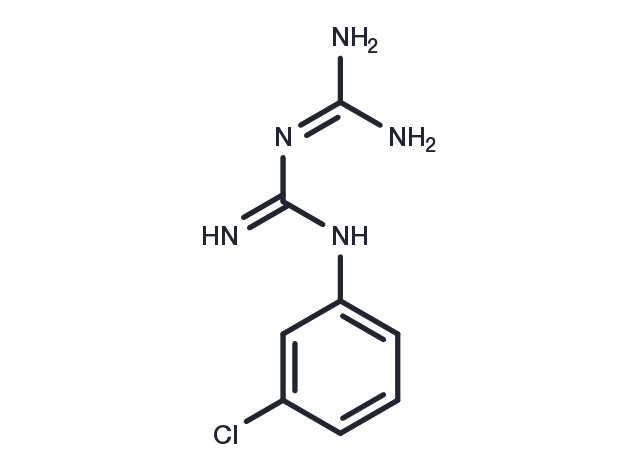store under nitrogen
Powder: -20°C for 3 years | In solvent: -80°C for 1 year

m-Chlorophenylbiguanide hydrochloride is a 5-HT3 receptor agonist. m-Chlorophenylbiguanide hydrochloride selectively binds 5-HT3(Ki: 0.002 µM) over 5-HT1A(Ki: 10 µM) and 5-HT2(Ki: 10 µM) receptors but also binds to high and low affinity sites on the dopamine transporter(DAT; IC50s: 0.4 and 34.8 µM, respectively, in rat caudate putamen synaptosomal membranes).

| Pack Size | Availability | Price/USD | Quantity |
|---|---|---|---|
| 100 mg | In stock | $ 42.00 |


| Description | m-Chlorophenylbiguanide hydrochloride is a 5-HT3 receptor agonist. m-Chlorophenylbiguanide hydrochloride selectively binds 5-HT3(Ki: 0.002 µM) over 5-HT1A(Ki: 10 µM) and 5-HT2(Ki: 10 µM) receptors but also binds to high and low affinity sites on the dopamine transporter(DAT; IC50s: 0.4 and 34.8 µM, respectively, in rat caudate putamen synaptosomal membranes). |
| Targets&IC50 | 5-HT1:10 µM(Ki), 5-HT2:10 µM(Ki), 5-HT3:0.002 µM(Ki) |
| In vivo | m-Chlorophenylbiguanide hydrochloride induces depolarization of isolated rat vagus nerve and stimulates inositol phosphate formation in rat frontocingulate cortical slices (EC50s = 0.05 and 4.2 μM, respectively).m-Chlorophenylbiguanide hydrochloride induces bradycardia, an effect that can be reversed by the 5-HT3 receptor antagonist ondansetron, in anaesthetized cats (ED50 = 20.3 nmol/kg)[1]. |
| Synonyms | 1-(3-Chlorophenyl)biguanidehydrochloride |
| Molecular Weight | 248.11 |
| Formula | C8H11Cl2N5 |
| CAS No. | 2113-05-5 |
store under nitrogen
Powder: -20°C for 3 years | In solvent: -80°C for 1 year
DMSO: 60 mg/mL (241.83 mM)
H2O: < 20 mg/mL (80.61 mM)
You can also refer to dose conversion for different animals. More
bottom
Please see Inhibitor Handling Instructions for more frequently ask questions. Topics include: how to prepare stock solutions, how to store products, and cautions on cell-based assays & animal experiments, etc.
m-Chlorophenylbiguanide hydrochloride 2113-05-5 GPCR/G Protein Neuroscience 5-HT Receptor 1-(3-Chlorophenyl)biguanidehydrochloride mChlorophenylbiguanide hydrochloride m-Chlorophenylbiguanide Hydrochloride m Chlorophenylbiguanide hydrochloride inhibitor inhibit
